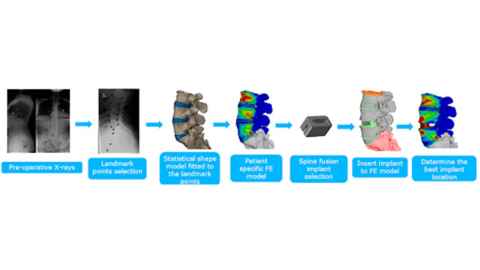Orthopaedic
Computational models to personalise treatment and optimise surgery planning.
Our research
Lumbar spine modelling for spinal fusion surgery
Degenerative spinal disc disorder (DDD) can lead to chronic low back pain which is one of the main musculoskeletal disorders with major disability. Surgical treatment consists of replacing the degenerative disc with a fusion implant. However incorrect placement of the implant and inability of restoring the natural lumbar spine curvature (lordosis) can lead to patients continuing to experience significant pain and/or failure of the adjacent discs due to changes in the axial loading of the spine. Computational modelling has the ability to predict clinical and functional outcomes but is highly dependent on the complex geometry of the musculoskeletal system and the ability to describe patient-specific loads and boundary conditions. We are working on developing a web-based tool to plan spinal fusion surgery for improved clinical outcome (Figure 1) by:
- Generating patient-specific 3 dimensional bone geometry by combining patient’s X-ray with a population shape model of the spine developed in the lab.
- Computing stress distribution in the lumbar spine and sacrum using a Finite Element model and predict the ideal implant placement to restore the optimal lumbar lordosis.

Members
- Julie Choisne
- Justin Fernandez
- Joe Baker
Funding partners
- MedTech CoRE
- Wishbone